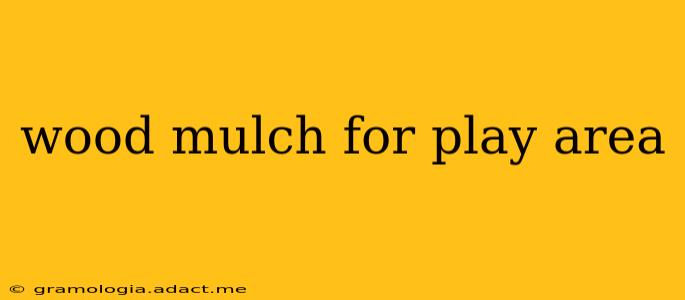Wood mulch is a popular choice for landscaping, and its use in play areas is widespread. However, choosing the right type and understanding its safety implications are crucial for creating a fun and safe environment for children. This comprehensive guide explores the benefits, risks, and best practices for using wood mulch in play areas.
Is Wood Mulch Safe for Play Areas?
This is the most crucial question parents and playground designers ask. The short answer is: it can be, but it depends on the type of wood and its treatment. Untreated wood mulch poses a lower risk of chemical exposure compared to treated wood. However, even untreated wood can harbor risks if not properly maintained. We'll delve deeper into these specifics below.
What are the Benefits of Using Wood Mulch in Play Areas?
Wood mulch offers several advantages for play areas:
- Soft Landing: Its cushioning effect reduces the impact of falls, minimizing injuries.
- Weed Suppression: It effectively prevents weed growth, keeping the play area clean and tidy.
- Moisture Retention: Wood mulch helps retain soil moisture, beneficial for the surrounding plants.
- Aesthetic Appeal: It provides a natural and visually appealing surface for play areas.
- Cost-Effective: Generally, wood mulch is a relatively affordable landscaping material.
What are the Risks Associated with Wood Mulch in Play Areas?
While offering benefits, wood mulch also presents potential risks:
- Splinters: Children can get splinters from untreated wood mulch, particularly if it's old or poorly maintained.
- Pest Infestation: Wood mulch can attract insects and rodents, posing a hygiene concern.
- Mold and Mildew Growth: In damp conditions, mold and mildew can grow on wood mulch, potentially triggering allergies or respiratory problems.
- Chemical Treatment: Pressure-treated wood can contain harmful chemicals like chromated copper arsenate (CCA), which is no longer used for residential purposes but might still be found in older mulch. Always confirm that the wood mulch is not CCA-treated.
What Type of Wood Mulch is Best for Play Areas?
The safest option is untreated hardwood mulch. Hardwoods are generally more durable and less prone to splintering than softwoods. Always check the source and ensure the mulch is specifically labeled as untreated and safe for playgrounds. Avoid any mulch that smells strongly of chemicals.
How Often Should Wood Mulch in Play Areas Be Replaced?
Regular maintenance is crucial. Ideally, wood mulch should be replaced every 1-2 years, or more frequently if it shows signs of significant decomposition, insect infestation, or excessive compaction. Regular raking also helps maintain a safe and clean play surface.
How Deep Should the Wood Mulch Be in a Play Area?
A depth of 2-4 inches is generally recommended for play areas. A shallower depth might not provide sufficient cushioning, while a deeper layer could present a risk of children getting buried.
What are the Alternatives to Wood Mulch for Play Areas?
Several alternatives to wood mulch exist, including:
- Rubber Mulch: Made from recycled rubber tires, it's durable, low-maintenance, and offers excellent shock absorption.
- Pea Gravel: A natural and aesthetically pleasing option but less effective at cushioning falls.
- Engineered Wood Fiber: A processed wood product designed for playgrounds, offering a softer and safer surface than traditional wood mulch.
Choosing the right surfacing material for your play area requires careful consideration. Prioritizing safety and regularly maintaining the chosen material are key to ensuring a fun and hazard-free environment for children. Always consult with landscaping professionals or playground safety experts for personalized advice.
